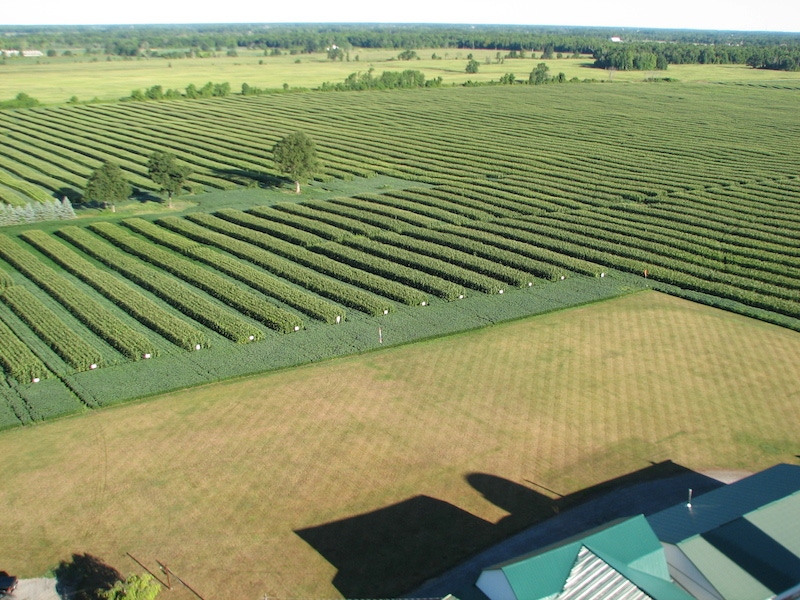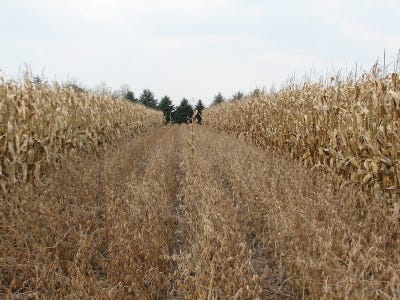
Think DifferentWhile Dean Glenney's system appears customized and multifacted, he is confident it can be adopted by others. Key elements of no-till and reduced traffic are easier to adopt today than when he started."Originally I had to leave a row of corn to eyeball the field," Glenney recalls. "Critics used to say it couldn't be done on a large scale, but with RTK controlled steering, 'fencerow farming' can be done by anyone. Just set up the pathways and never leave them. It's fun to combine 300-bushel corn."
February 5, 2015

Dean Glenney set out to replicate the undisturbed fencerow soils he recalled plowing up in his youth. Along the way, he began producing record-breaking yields under low inputs, giving him returns considerably greater than neighboring conventional systems. His system, which he calls fencerow farming, is a unique approach to controlled traffic that combines no-till with alternating strips of twin-row corn and soybeans.
"My soil is like what you find if you dig into an undisturbed fencerow, with its defined soil structure," Glenney says. "When I dig up a chunk of soil, it is so mellow that it just crumbles through my fingers like little sugar cubes when I try to pick it off the spade."
Glenney’s system is paying off in numerous ways. While the corn average in his southern Ontario county – which shares the same latitude with the Minnesota/Iowa border – is around 150 bushels per acre, he is producing dryland yields of around 300 bushels.
Intrigued, researchers are now mining his “fencerow farming” system to boost plant health and yields across the Corn Belt.
Twin rows, crop strips, controlled traffic
An ag engineer, Glenney began working on his fencerow farming project on his 200-acre home farm in 1994 after selling a sideline berry operation. By never deviating from the path of planting directly on previous-year rows with his six-row planter, wheel traffic is restricted over the years to two paths, which leaves four rows untraveled. George Lazarovits, research director, A&L Canada Laboratories, believes the practice has affected the biology of the plants.
"By repeatedly planting into the root zone, he has built up the same microorganisms, pre-inoculating the soil," Lazarovits explains.
Glenney figured twin-row spacing would also enable higher plant populations, and alternating crop strips would increase light to outside cornrows. He set up his new White planter with a splitter bar to create twin rows (for both corn and soybeans) with 8-inch spacings and 22 inches between sets of twin rows. Seeds are spaced every 10 inches.
"I figure I pick up 20 bushels per acre with the extra light from the strip cropping," says Glenney, who usually plants around 38,000 seeds per acre.
Glenney expected to sacrifice soybean yields, but they average 60 bushels per acre with a high yield of 72 bushels. His best yields have been at 170,000 seeds per acre, “but I've also had 90,000 seed plots come out the same. I think I know what makes corn tick, but not soybeans.”
Five years later
The first years of the system weren't pretty, he admits, and required planter modifications. However, after about five years, something started to happen.
"One round at harvest is an acre and a half, and I had never had a problem making it back to the wagon," Glenney recalls. "In the sixth year, the full-bin buzzer went off, and I was still 350 feet from the end of the round. I had a 230-bushel-per-acre yield. "
That was in 2000, and the yields kept climbing annually to a province high of 283 in a 2010 Pioneer yield contest. While his farm average that year was 245 bushels per acre, he was still just fertilizing for 150 bushels.
With funding from the Ontario Corn Growers, A&L Canada Laboratories research director George Lazarovits and A&L researcher Rafiq Islam began a two-year study in 2012. Using the same corn hybrid, they compared a plot in Glenney's fields with a neighbor's conventionally farmed field, which was in the second year of a corn/corn/soybean rotation.
While the conventional field had much higher cation exchange capacity and twice the organic matter, the soil structure between fields was noticeably different: Glenney's soil was loose and without compaction.
The neighbor followed his usual program, chisel plowing in the fall and two field cultivator passes before planting. In between passes, he broadcast 100 pounds of nitrogen, 25 pounds of phosphate and 60 pounds of potash. He planted 34,000 seeds per acre in 30-inch rows at 6-inch spacings with 167 pounds of 20-50-30 starter in a 2x2 band. At V3, he knifed in 42 gallons of 28% nitrogen.
oDean Glenney's fencerow fields are so biologically active that by mid-season, lower leaf tips are pulled into large earthworm tunnels. Dr. George Lazarovits, A
Glenney also followed his usual practices, planting 38,000 seeds per acre. He applied 30 gallons of 28% nitrogen to the outsides of the twin rows and a band of 10-54-60 between the rows, along with 4 gallons of Alpine 6-24-6 over the seed row. When the corn reached 18-20 inches, he sidedressed the twin rows with 28 percent nitrogen for a total of 205 pounds actual nitrogen. He also applied two tons of mushroom compost per acre, but it was high in salt at 3%. The soybeans had to be replanted. The corn, looking worse than usual, survived.
While the conventional field showed uniform emergence and excellent growth, emergence in Glenney’s plot seemed exceptionally uneven and plants appeared stunted with less developed roots. However, at 26 days after planting, plant vigor was much higher in Glenney’s plot, which had twice total biomass as the conventional field.
Glenney was not surprised when conditions changed. "At about 10-12 inches, it is like a switch turns on, and my plants turn dark – almost black green – and take off," he says.
By 60 days after planting, Glenney’s plot had significantly greater root growth and levels of biomass and chlorophyll. The comparisons were even more dramatic at 87 days after planting, when Glenney’s plot showed biomass up by nearly 19% and chlorophyll by 81%, and root growth greater by 35%. Root systems were larger, more branched, thicker and longer than those from the conventional site. Nodal roots were more numerous and better developed.
Soil health benefits
While total soil life was more diverse, 84% of the soil bacteria around the roots was Pseudomonas spp. However, it paid off in healthier plants, as this microbial family is known for plant growth promotion, producing disease-suppressive soils and producing antibiotics for biological control. Pseudomonas spp. levels in the neighboring field were only at 48%.
Ear diseases were significantly higher in the conventional plot, with severe and moderate infections greater by a factor of more than 10. At harvest, Glenney’s plot produced larger ears and 30% more and bigger kernels for 45% more grain estimated per plant.
When averaged out over the initial plant counts, yields were estimated at 220 bushels per acre on the Glenney plot versus 160 on the conventional. However, late-emerging plants (post-plant count) on the Glenney plot boosted actual yield to 249 bushels per acre. The partially irrigated farm posted a dryland average of 293 bushels per acre. Meanwhile, the county averaged 135 bushels.
Better nutrient availability
Lazarovits and Islam studied the biome to explain the yield differential between the plots. Nutritional values were similar, but the story in the soil and plants themselves was vastly different. In addition to the microbial findings, analysis of the soil in rootballs at 60 and 87 days after planting revealed that 96% of the available nitrate was utilized in the Glenney plot, compared to 55% at the conventional site. The phosphorus level at the conventional site remained constant at 8%, while phosphorus increased from 10% to 18.5% in the Glenney plot, suggesting that arbuscular mycorrhizal fungi were solubilizing phosphate.
While variances were also seen in micronutrients, soil life appeared to benefit most from the long term, no-till, controlled-traffic system. Lazarovits points out that earthworms, which can live up to eight to 10 years, showed remarkable levels of activity, along with other soil life in Glenney’s fields.
"His number one challenge is planting through 4-6 inches of organic debris in the spring, and yet within six weeks, there is no trash left in the field," says Lazarovits. "Later in the season, as lower leaves dry and droop, the larger earthworms actually drag the tips into their holes in the soil. All that fertility is being brought back into the soil, leaving nutritious worm castings available to the plant."

oStrips of corn yielding 300 bushels per acre and soybeans producing 72 bushels per acre prove the value of Dean Glenney's fencerow farming system. Restricted traffic, no-till and crop rotation are complemented by twin rows on 30-inch centers. Even planter coulters have followed the same precise path for two decades. Photo: Dean Glenney
Lazarovits and Islam repeated the plots in 2013, with similar results. Over the two years, fencerow farming yielded 75% more than the conventional plot, yet with the same input costs.
Meanwhile, Glenney's yields have topped off around 300 bushels per acre. He continues exploring new options as he works with the researchers, experimenting with foliar feeding and fungicides and attempting in-crop cover crop seeding. New stresses arrived in 2014 with a late spring. Glenney planted corn June 1 and soybeans on June 15. Rain was sporadic until the first of August, when it stopped until the first of September. An early frost before maturation produced grade four corn.
While his worst field was down around 180 and soybeans averaged only 41 bushels, “we still had the best corn around, with our test plots yielding 245 to 268,” Glenney says.
Lazarovits is hopeful that continued evaluations of the microbial populations will show the way to even higher yields. He questions the continued heavy investment in breeding versus agronomics when current cultivars are being underutilized for their productivity.
"We are working with Greg Gloor at the University of Western Ontario to do in-depth sequencing of what is going on in the field's ecosystem, measuring functionality of organisms in the plant," Lazarovits says. " It took Glenney five years to build his ecosystem. If we identify and understand the organisms, perhaps we can establish them more quickly and maintain them. "
About the Author(s)
You May Also Like



